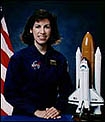People |
Meet
Dr. Ellen Ochoa: Dr. Ochoa's Biographical Sketch |
 |
| Meet
Dr. Ellen Ochoa: Dr. Ochoa's Biographical Sketch NAME: Ellen Ochoa (Ph.D) NASA Astronaut PERSONAL DATA: Born May 10, 1958 in Los Angeles, California, but considers La Mesa, California, to be her hometown. She is married to Coe Fulmer Miles of Molalla, Oregon. Dr. Ellen Ochoa is a classical flutist and private pilot, and also enjoys volleyball and bicycling. Her mother, Rosanne Ochoa, resides in La Mesa. EDUCATION: Graduated from Grossmont High School, La Mesa, California, in 1975; received a bachelor of science degree in physics from San Diego State University in 1980, a master of science degree and doctorate in electrical engineering from Stanford University in 1981 and 1985, respectively. ORGANIZATIONS: Member of the Optical Society of America (OSA), the American Institute of Aeronautics and Astronautics (AIAA), Phi Beta Kappa and Sigma Xi honor societies. SPECIAL HONORS: NASA awards include the Exceptional Service Medal (1997), Outstanding Leadership Medal (1995), Space Flight Medals (1994, 1993), and two Space Act Tech Brief Awards (1992). Recipient of numerous other awards, including most recently the Women in Aerospace Outstanding Achievement Award, The Hispanic Engineer Albert Baez Award for Outstanding Technical Contribution to Humanity, the Hispanic Heritage Leadership Award, and San Diego State University Alumna of the Year. EXPERIENCE: As a doctoral student at Stanford, and later as a researcher at Sandia National Laboratories and NASA Ames Research Center, Dr. Ochoa investigated optical systems for performing information processing. She is a co-inventor on three patents for an optical inspection system, an optical object recognition method, and a method for noise removal in images. As Chief of the Intelligent Systems Technology Branch at Ames, she supervised 35 engineers and scientists in the research and development of computational systems for aerospace missions. Dr. Ochoa has presented numerous papers at technical conferences and in scientific journals. Selected by NASA in January 1990, Dr. Ochoa became an astronaut in July 1991. Her technical assignments to date include flight software verification, crew representative for flight software and computer hardware development, crew representative for robotics development, testing, and training, and Assistant for Space Station to the Chief of the Astronaut Office, directing crew involvement in the development and operation of the Station. A veteran of two space flights, Dr. Ochoa has logged over 484 hours in space. She currently serves as a spacecraft communicator (CAPCOM) in Mission Control. In April 1993, Dr. Ochoa flew as a Mission Specialist on STS-56, carrying ATLAS-2. During this 9-day mission the crew of Discovery conducted atmospheric and solar studies in order to better understand the effect of solar activity on the Earth's climate and environment. Dr. Ochoa used the Remote Manipulator System (RMS) to deploy and capture the Spartan satellite, which studied the solar corona. Dr. Ochoa was the Payload Commander on the STS-66 Atmospheric Laboratory for Applications and Science-3 mission (November 3-14, 1994). ATLAS-3 continues the series of Spacelab flights to study the energy of the Sun during an 11-year solar cycle and to learn how changes in the sun's irradiance affect the Earth's climate and environment. Dr. Ochoa used the RMS to retrieve the CRISTA-SPAS atmospheric research satellite at the end of its 8-day free flight. Courtesy of NASA, http://WWW.JSC.NASA.GOV/Bios/htmlbios/ochoa.html
But for me, it was a little different. For one thing, when I was your age, we had astronauts who landed on the moon for the first time -- probably when I was about your age, about eleven. But at that time, there weren’t any women astronauts and also very few who were scientists. Most of them were pilots in the military at that point. So it didn’t occur to me when I was in school that this was something I could grow up and do. But as the space program evolved as I said we’ve moved more from piloting into science and engineering.
|
||
[
Meet Dr. Ellen Ochoa ]
[ Impacto, Influencia, Cambio ]
[ History of Science, Technology
and Invention ]